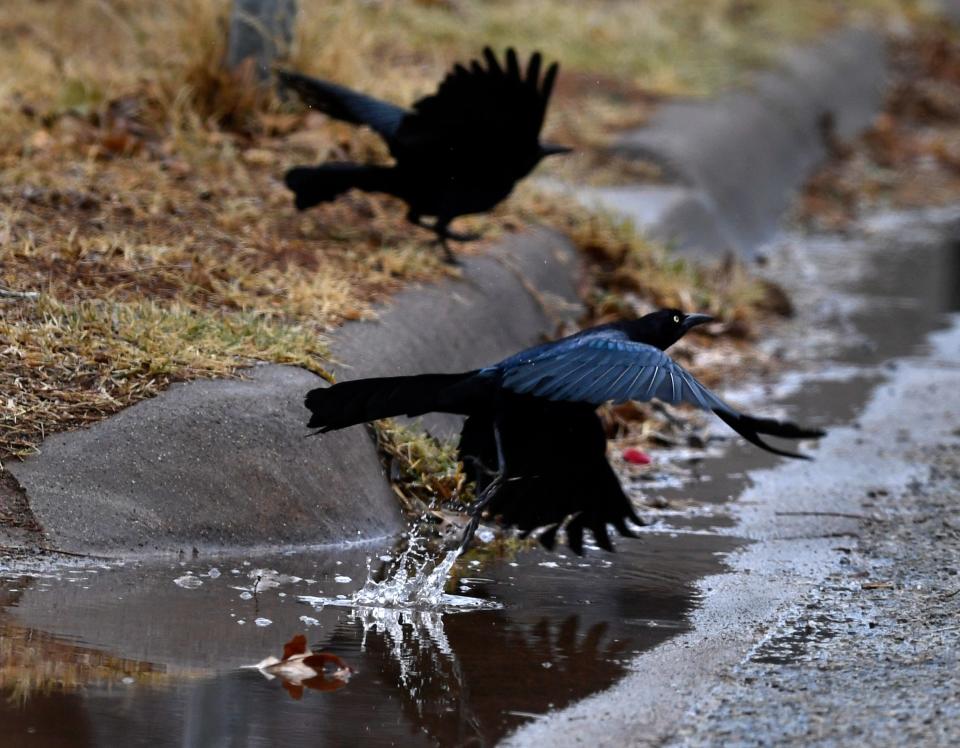Welcome, birds! Here's how and what to feed summer guests at your home
Something else that skyrocketed during the pandemic was backyard bird-watching. Many people are enjoying local birds and the migratory flocks that come through and put out feed to entice them to their yards. Sounds fun, right?
But some would argue that feeding wild birds is a disservice because it could negatively impact their nutrition if they fill up on “junk food” filler. And it may bring them closer to predators such as your family cat. Or it may encourage them to fly into a home or building’s large glass windows resulting in injury or death.
Here’s how to avoid all that while continuing to enjoy birds in your backyard:
Spread feeders
Spreading bird feeders limits the risk of spreading disease and avoid a high concentration of bird poop in one area. Consider putting the bird feeders where the risk from predators is low: perhaps under a heavy tree canopy so they aren’t attacked from above, and high enough off the ground to avoid capture by Tabby the cat. Clean your feeder often to avoid mold or rot. And, most important, select a high-quality birdfeed if possible, not just the cheapest thing on the shelf.
Types of feed
What feed you select depends on the birds you have or are trying to attract.
Read the label carefully. Wild bird feed sold in nurseries or garden centers is generally formulated to supplement the bird’s diet and is not intended to be its sole source of nutrition. Birdfeed in grocery stores, while cheaper, may be just filler and not a good nutritional source at all. Be wary if the content is heavy with milo, oats, and hulls. It’s inexpensive to buy but expensive to feed, as birds will likely just scatter it about rather than eat it.
To attract cardinals, blue jays, woodpeckers and doves, look for sunflower seed that has 40% fat (preferably from black oil), 16% protein, and 20% carbohydrates.
If, for some bizarre reason, you want to attract grackles and squirrels, look for safflower seeds with 36% fat and 34% carbohydrates, or any kind of peanut product.
Ground-feeding birds are attracted by millet. Look for a mix of 44% fat, 11% protein and 73% carbohydrates.

The ideal source of protein would be black oil sunflower seed; cracked corn is best for the carbs; and suet for fat. But there are other sources available, with pros and cons to each.
Note that mealworms are a great attractor to bluebirds but have a tendency to go bad quickly. If you feed them, check the bag carefully before dispersing, and be prepared to clean out the feeders more often. Nyier is a very small feed that is easily blown away and wasted by the wind, so select a bird feeder with a very small opening if feeding this.
Most smaller birds can’t handle whole peanuts. They appeal to some of the larger predator birds you likely don’t want. As well as squirrels! The same is true with whole corn. Cracked corn is easier for birds to eat, but still attracts squirrels so placement of your feeder is important.
If you’re looking for hummingbirds, having appropriate garden plants is the best option, but mixing water with sugar in a 4-to-1 ratio works well. (It’s helpful to boil the water to make sure the sugar thoroughly dissolves, and obviously, cools before dispersing into the feeder.) Clean the feeder thoroughly and replace any leftover mixture every four to five days. Try to avoid placing hummingbird feeders where they are exposed to afternoon heat.
Save the birds
Consider putting up stickers, wind chimes, other hanging ornaments, reflective tape or other means to make it clear to the birds visiting your backyard that your windows are not an open invitation to come on in.
Nothing spoils the joy of watching our feathered friends more than contributing to an avoidable injury.
If you want to put out fruit for birds, either fresh or dried, put it in a tray up off the ground or hang it from a fence or tree to prevent bugs and other critters from getting it. It needs to be replaced frequently. Avoid scattering milo, sorghum, oats, rice, and buckwheat, as they are expensive and empty fillers that you don’t need in your lawn.
Putting out birdfeed is an open invitation for birds to dine with you. Make sure you are offering a meal that helps these winged beauties.
Upcoming events
June 3: Lake hike at Abilene State Park. Be at the Lake Abilene parking area by 9 a.m. Bring water and appropriate footwear for the five-mile hike.
June 10: Star party (weather permitting), 9:00 p.m. Abilene State Park. Meet near the swimming pool (unless otherwise directed by park staff).
June 15: Chapter meeting, Taylor County Extension office, 6:30 p.m.
Gary L. Wilson is an avid bird watcher and photographer. Now retired, he was a professor of animal nutrition at the TCU Ranch Management Program and previously formulated feeds for Continental Grain.
Gary is a member of the Big Country Master Naturalist program here in Abilene. All master naturalists are volunteers interested in the great Texas outdoors. From our backyards to natural spaces across the state, master naturalists are learning, sharing and protecting our natural resources. To learn more about the Texas Master Naturalist program and how tp get involved, go to txmn.tamu.edu or our local Facebook page @BCTXMN.
This article originally appeared on Abilene Reporter-News: Welcome, birds! Here's how and what to feed summer guests at your home

